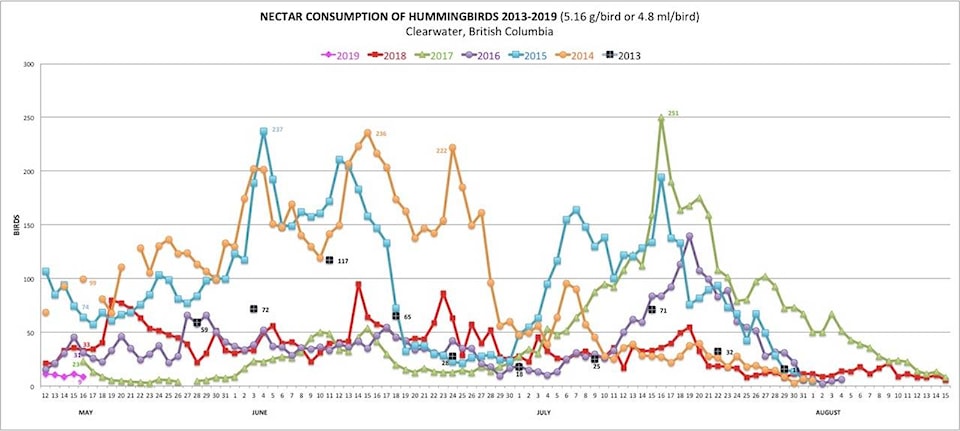By Dennis Leonard
Your Rufous Hummingbirds should have shown up by now. But there are concerns about their welfare as related from an article (https://blog.scienceborealis.ca/hummingbirds) in Science Borealis, April 1, 2019 titled: Hummingbirds: The forgotten pollinator when it comes to pesticides.
I expect you’ve heard about the decline of bees due to neonicotinoids (“neonics”). It appears neonics, along with other factors, affect avian pollinators as well, since between 1966 and 2014, the global population of rufous hummingbirds declined by 62 per cent.
So research was needed, resulting in the collaboration between Dr. Christine Bishop, research scientist with Environment and Climate Change Canada (ECCC) and Alison J. Moran, the hummingbird guru for the province, who organizes hummingbird banding for British Columbia.
Now hummingbird banders may be able to add the letters HMPS after their name (Hummer Mini Pooper Scooper) as they collect excretions often presented by the hummers while being banded.
https://www.clearwatertimes.com/trending-now/ever-see-birds-perform-a-mating-dance-western-grebes-flap-around-at-b-c-wharf/
“In the first two years of their study, they detected three neonicotinoid insecticides in rufous and Anna’s hummingbird urine — imidacloprid, thiamethoxam, and clothianidin. They also collected bumblebees and their pollen, and blueberry leaves and flowers to test for pesticides.
“In one of six blueberry flower samples, they detected imidacloprid even a year after its application. This means that hummingbirds could be exposed to imidacloprid from a flower that was not directly sprayed with pesticides,” stated the article.
The effects of these pesticides are not known for hummingbirds, but studies done on other birds raise concern as related in another article in Nature.com, “Imidacloprid and chlorpyrifos insecticides impair migratory ability in a seed-eating songbird”.
The gears of decision grind slowly and Health Canada’s Pest Management Regulatory Agency (PMRA) does not appear to have banned these pesticides. Even if they did, it would likely be a three to five-year phase out while the European Union has banned them already.
What can you do about neonics? Contact The Honourable Ginette Petitpas Taylor, Minister of Health (one can do so via davidsuzuki.org/action/canada-must-ban-neonics-now/) supporting a ban. Don’t buy plants from a nursery that uses neonics. Don’t use them on your property. Try to purchase food grown without pesticides.
At my place, the start of this hummer season is disconcerting with the lowest consumption in six years on May 16. Two other households in my area have indicated consumption is much lower as well, but no data is available. As you can see by the chart, consumption can vary considerably one day to the next and year to year.
Tracking nectar consumption of the hummers at your feeder(s), as I have done since 2013, may help researchers, but I don’t expect others to do this every day even though it only takes a few minutes per feeder. How about once or twice a week on the same day(s) then passing the data on to me for charting. Data would be more relevant with several households joining in.
If you are interested please contact me at 250-674-2518 for instructions or just call to indicate how this year compares to previous ones at your location.
Alison Moran emailed me that hummingbirds, “are substantially behind normal on the coast (three to four weeks late)…an excellent return in the south Okanagan and they are getting huge numbers in the Cariboo heading up the Fraser.”
She also wrote, “With respect to the feeder information, there is no reason that I know to be concerned about organic sugar. However, it is very expensive and there is no need to choose it over refined, which we know is clean (not contaminated with pesticides as claimed). My main concern is with brown sugar, which does contain iron. There is good information about haemochromatosis (retention of iron) in many species and the reason is that there is little iron in the natural diet”
So, continue to feed one part white refined sugar (cane or beet) added to four parts water, preferably not heavily dosed with chlorine.
Perhaps numbers will increase soon, but it feels more like the numbers will be down as in 2017.
Hope you have a good hummer season and continue to marvel at their abilities.
newsroom@clearwatertimes.com
Like us on Facebook and follow us on Twitter
